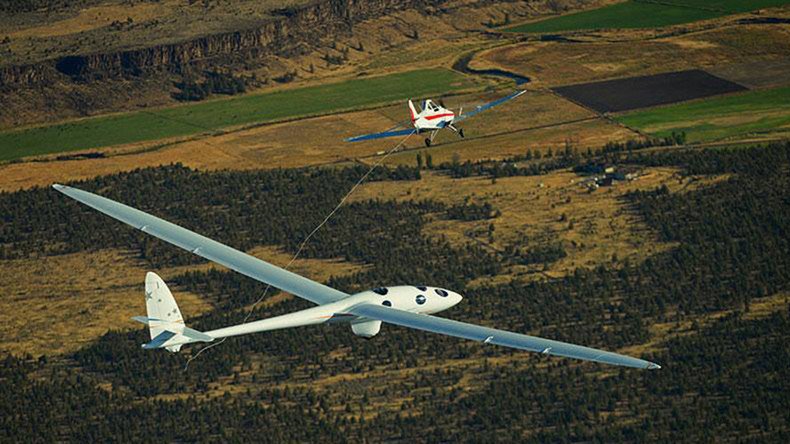Look, no engine! Wind-powered glider set to explore edge of space (PHOTOS, VIDEO)

A team of aerospace engineers are trying to smash manned aircraft altitude records by floating an “unpowered” glider into the upper echelons of the Earth’s atmosphere.
Engine-powered planes have never reached a height of 90,000 feet – the closest was the US SR-71 Blackbird spy plane which flew to a height of 85,069 feet.
The Perlan 2 glider is different to any other venture into the stratosphere, however, as it doesn’t have an engine and instead is wind powered, relying on a combination of rising hot air and wind currents from mountain peaks for lift.
A tow-plane provides Perlan 2 with help in getting airborne, before the huge glider is left to surf the airwaves towards space.
A venture started by the late US adventurer Steve Fossett, the 84-foot wingspan glider appears to be more than just a flight of fancy with engineers hoping it can be used for future atmospheric research.
The Perlan team, made up of former US Air Force pilots, meteorologists, and co-founder Einar Enevoldson, believe there is also potential to develop the glider for flight on low air density alien planets.
The aircraft has a maximum speed of 168mph, and it is fitted with oxygen tanks and a “ballistic chute” should the two pilots suddenly need to eject.
So far, the multimillion dollar aircraft has made only one pressurized flight, according to financial backer Airbus. The latest testing was hampered by “adverse weather conditions” last weekend.
Out of the boardroom & into the cockpit! View of Airbus Group CEO Tom Enders co-piloting #Perlan2 yesterday. pic.twitter.com/7hy3hrYdgL
— Perlan Project (@PerlanProject) May 8, 2016
Europe’s Airbus - makers of commercial airliners, military drones and bombers - has poured at least $4million into the glider’s design, report Phys.org.
The glider looks set to be deployed in Argentina later this year, where Airbus say mountain airwaves are expected to propel the flight into the stratosphere.
Despite the weather-related test setback on Sunday, Airbus CEO Tom Enders insists the aircraft “will fly in a region of our atmosphere where no other aircraft has operated for sustained periods, and in doing so it will change our fundamental understanding of how the atmosphere works.”
While the mission sounds like an impossible feat, the aircraft’s predecessor, the Perlan I, managed to break flight records in 2006 by soaring to an altitude of 50,722 feet.
The Perlan Mission II team believe they will need the extremely strong winds of the Polar Vortex to lift them to their goal.
What IS the #PolarVortex? NOAA's @NWSNewYorkNY explains what it is -- and isn't -- in 1 easy graphic. #ColdOutbreakpic.twitter.com/SjT41AlhFJ
— NOAA (@NOAA) January 6, 2014
“With more wing area than a conventional sailplane, it would stay aloft, but never compete with such craft at lower altitudes. But in the thin air at 90, 000 feet, with 98 percent of the earth’s atmosphere beneath it, it will be unrivalled,” Perlan’s creators say.












